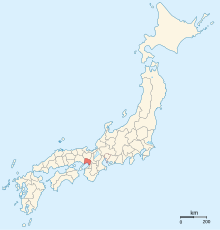Settsu Province

Settsu Province (摂津国, Settsu no kuni) was a province of Japan, which today comprises the eastern part of Hyōgo Prefecture and the northern part of Osaka Prefecture.[1] It was also referred to as Tsu Province (津国, Tsu no kuni) or Sesshū (摂州).
Osaka and Osaka Castle were the main center of the province.
History
During the Sengoku period, the Miyoshi clan ruled Settsu and its neighbors, Izumi and Kawachi, until they were conquered by Oda Nobunaga. The provinces were ruled subsequently by Toyotomi Hideyoshi. The regents of Hideyoshi's son soon quarreled, and when Ishida Mitsunari lost the Battle of Sekigahara, the area was given to relatives of Tokugawa Ieyasu. It was from then on divided into several domains, including the Asada Domain.
Sumiyoshi taisha was designated as the chief Shinto shrine (ichinomiya) for the province. [2]
During the Sengoku period Settsu became the main exporting centre of matchlock firearms to the rest of Japan.
The Kohama style (小浜流, Kohama-ryū) of sake brewing was practiced at the Kohama-juku (小浜宿) in the Amagasaki Domain of Settsu Province during the Edo Period.
Notes
- ^ Nussbaum, Louis-Frédéric. (2005). "Settsu" in Japan Encyclopedia, p. 846, p. 846, at Google Books; n.b., Louis-Frédéric is pseudonym of Louis-Frédéric Nussbaum, see Deutsche Nationalbibliothek Authority File.
- ^ "Nationwide List of Ichinomiya," p. 3.; retrieved 2011-08-09
References
- Nussbaum, Louis-Frédéric and Käthe Roth. (2005). Japan encyclopedia. Cambridge: Harvard University Press. 10-ISBN 0-674-01753-6; 13-ISBN 978-0-674-01753-5; OCLC 58053128
